Responses of Concrete Using Steel Slag as Coarse Aggregate Replacement under Splitting and Flexure
Abstract
:1. Introduction
- (a)
- Even though most engineering parameters of concrete have been taken under compression, researchers have still studied its tensile properties together. This is due to the fact that many structural members in a construction contained a tensile stress phase on a part of the cross-section, e.g., beam structures, eccentric-loaded columns. The splitting tensile test and the flexural tensile test were used in this research because these testing types were comparatively simpler and easier than direct tensile tests [22,23].
- (b)
- Both compressive cube specimens and compressive cylinder specimens have been commonly used according to testing standards. The cylinder specimen with a diameter of 150 mm and a height of 300 mm has been applied primarily in Canada, United States, and Australia. On the contrary, the cube specimen with dimensions of 150 mm or 100 mm has been used largely in Europe and Vietnam [24]. In general, the splitting specimen may be different from a compressive specimen in shape, however, it is very convenient if they are identical: no need for various mold types and time is saved for specimen preparation. Therefore, the cube specimens and cylinder specimens were examined then evaluated in this investigation.
- (c)
- Concretes and/or quasi-brittle materials, with their brittle nature, have revealed the size-dependent mechanical properties [25,26,27]. In the previous study [21], the authors explored the clear size effect on the compressive strength of CSCs. How does size and shape affect the splitting strength of CSCs? And how will splitting test methods affect the splitting strength of CSCs, despite using identical-sized specimens? An investigation is required to obtain conversion factors for CSCs using various sizes of splitting specimens, as well as splitting test methods; this would help civil engineers transfer rapidly from one to others.
2. Direct and Indirection Tensile Test of Concrete
2.1. Splitting Tension
2.2. Flexural Tension
3. Experiment
3.1. Materials, Mixtures and Specimen Preparation
3.2. Test Setup
4. Results and Discussion
4.1. Splitting Test
4.1.1. Splitting Behaviors of CSC2
4.1.2. Influence of Testing Methods on Splitting Strength of CSC
4.1.3. Conversion Factors for Splitting Specimens of CSC with Different Specimen Types
4.1.4. Brittleness Indicator Regarding Splitting Strength of CSC2
4.2. Response of CSCs under Flexure
4.2.1. Flexural Strength of Plain CSCs
4.2.2. Flexural Behaviors of Reinforced CSC Beams
4.2.3. Crack Patterns of the Tested Beams
4.2.4. Co-Relationship between Curvature, Deflection and Flexural Strain
5. Conclusions
- With the same size, the order of splitting test methods, in terms of the splitting strength of the coarse steel slag concrete, was as follows: cylinder splitting > diagonal-cube splitting > side-cube splitting. Besides, the cylinder splitting was highly stable under loading, whereas the two others were not.
- The coarse steel slag concrete exhibited a splitting strength that was clearly size-dependent, for both side-cube splitting specimens and cylinder splitting specimens. In addition, the conversion factors for splitting strength were derived for various splitting series; they were useful in quickly translating the splitting strength from one to others. The side-cube splitting specimens exhibited more sensitivity to size than the cylinder splitting specimens.
- The brittleness indicators of the coarse steel slag concrete, defined as the Weibull modulus according to Weibull’s size effect law, were analytically achieved as follows: = 3.27 for side-cube splitting specimens and = 17.02 for cylinder splitting specimens. The brittleness indicators of various kinds of concrete, under different loading types, were comparatively reviewed.
- The flexural strength of the plain coarse steel slag concrete increased with increasing of testing age, it was also suitable with compressive strength. The derived conversion factors for flexural strength were somewhat similar to that of traditional concrete.
- The increase in compressive strength of coarse steel slag concretes produced an increase in all flexural parameters at LOP, including load carrying capacity, midspan deflection capacity, midspan flexural strain, and energy absorption capacity. However, at MOR, an increase in compressive strength generated an increase in load-carrying capacity at MOR only, but a decrease in other flexural parameters.
- The flexural parameters of the tested reinforced beams, using coarse steel slag concrete, were generally consistent with the theory for traditional concrete. Under loading, there was a strong co-relationship between the initiation and propagation of the crack, curvature, deflection, and flexural strength.
Author Contributions
Funding
Acknowledgments
Conflicts of Interest
References
- Mehta, P.K.; Monteiro, P.J. Concrete Microstructure, Properties and Materials, 4th ed; McGraw-Hill Education: New York, NY, USA; Chicago, IL, USA; San Francisco, CA, USA; Athens, Greece; London, UK; Madrid, Spain; Mexico City, Mexico; Milan, Italy; New Delhi, India; Singapore; Sydney, Australia; Toronto, ON, Canada, 2014. [Google Scholar]
- Shi, C. Steel slag—Its production, processing, characteristics, and cementitious properties. J. Mater. Civ. Eng. 2004, 16, 230–236. [Google Scholar] [CrossRef]
- Rađenović, A.; Malina, J.; Sofilić, T. Characterization of ladle furnace slag from carbon steel production as a potential adsorbent. Adv. Mater. Sci. Eng. 2013, 2013, 1–6. [Google Scholar] [CrossRef] [Green Version]
- Pasetto, M.; Baliello, A.; Giacomello, G.; Pasquini, E. Sustainable solutions for road pavements: A multi-scale characterization of warm mix asphalts containing steel slags. J. Clean. Prod. 2017, 166, 835–843. [Google Scholar] [CrossRef]
- Galán-Arboledas, R.J.; de Diego, J.Á.; Dondi, M.; Bueno, S. Energy, environmental and technical assessment for the incorporation of EAF stainless steel slag in ceramic building materials. J. Clean. Prod. 2017, 142, 1778–1788. [Google Scholar] [CrossRef]
- Poulikakos, L.; Papadaskalopoulou, C.; Hofko, B.; Gschösser, F.; Falchetto, A.C.; Bueno, M.; Arraigada, M.; Sousa, J.; Ruiz, R.; Petit, C. Harvesting the unexplored potential of European waste materials for road construction. Resour. Conserv. Recycl. 2017, 116, 32–44. [Google Scholar] [CrossRef]
- Kourounis, S.; Tsivilis, S.; Tsakiridis, P.E.; Papadimitriou, G.D.; Tsibouki, Z. Properties and hydration of blended cements with steelmaking slag. Cem. Concr. Res. 2007, 37, 815–822. [Google Scholar] [CrossRef]
- Zhang, T.; Yu, Q.; Wei, J.; Li, J.; Zhang, P. Preparation of high performance blended cements and reclamation of iron concentrate from basic oxygen furnace steel slag. Resour. Conserv. Recycl. 2011, 56, 48–55. [Google Scholar] [CrossRef]
- Li, J.; Yu, Q.; Wei, J.; Zhang, T. Structural characteristics and hydration kinetics of modified steel slag. Cem. Concr. Res. 2011, 41, 324–329. [Google Scholar] [CrossRef]
- Song, J.; Nguyen, D.L.; Manathamsombat, C.; Kim, D.J. Effect of fiber volume content on electromechanical behavior of strain-hardening steel-fiber-reinforced cementitious composites. J. Compos. Mater. 2015, 49, 3621–3634. [Google Scholar] [CrossRef]
- Nguyen, D.-L.; Lam, M.N.-T.; Kim, D.-J.; Song, J. Direct tensile self-sensing and fracture energy of steel-fiber-reinforced concretes. Compos. Part B 2020, 183, 107714. [Google Scholar] [CrossRef]
- Mo, L.; Zhang, F.; Deng, M.; Jin, F.; Al-Tabbaa, A.; Wang, A. Accelerated carbonation and performance of concrete made with steel slag as binding materials and aggregates. Cem. Concr. Compos. 2017, 83, 138–145. [Google Scholar] [CrossRef]
- Palankar, N.; Shankar, A.R.; Mithun, B.M. Durability studies on eco-friendly concrete mixes incorporating steel slag as coarse aggregates. J. Clean. Prod. 2016, 129, 437–448. [Google Scholar] [CrossRef]
- Monosi, S.; Ruello, M.L.; Sani, D. Electric arc furnace slag as natural aggregate replacement in concrete production. Cem. Concr. Compos. 2016, 66, 66–72. [Google Scholar] [CrossRef]
- Netinger, I.; Bjegović, D.; Vrhovac, G. Utilisation of steel slag as an aggregate in concrete. Mater. Struct. 2011, 44, 1565–1575. [Google Scholar] [CrossRef]
- Tran, A.T.; Tran, G.H.; Nguyen, N.T.H.; Nguyen, K.S. Characterization of carbonated steelmaking slag and its potential application in construction. Vietnam J. Sci.Technol. 2019, 57, 61. [Google Scholar] [CrossRef] [Green Version]
- Lam, M.N.T.; Jaritngam, S.; Le, D.H. Roller-compacted concrete pavement made of Electric Arc Furnace slag aggregate: Mix design and mechanical properties. Constr. Build. Mater. 2017, 154, 482–495. [Google Scholar] [CrossRef]
- Lam, M.N.T.; Le, D.H.; Jaritngam, S. Compressive strength and durability properties of roller-compacted concrete pavement containing electric arc furnace slag aggregate and fly ash. Constr. Build. Mater. 2018, 191, 912–922. [Google Scholar] [CrossRef]
- Lam, M.N.T.; Jaritngam, S.; Le, D.H. EAF Slag Aggregate in Roller-Compacted Concrete Pavement: Effects of Delay in Compaction. Sustainability 2018, 10, 1122. [Google Scholar] [CrossRef] [Green Version]
- Nguyen, T.T.H.; Phan, D.H.; Mai, H.H. Modified compositions of concretes using steel slag coarse aggregate. J. Build. 2016, 2, 63–71. [Google Scholar]
- Nguyen, T.-T.-H.; Phan, D.-H.; Mai, H.-H.; Nguyen, D.-L. Investigation on Compressive Characteristics of Steel-Slag Concrete. Materials 2020, 13, 1928. [Google Scholar] [CrossRef]
- Neville, A.M. Properties of Concrete, 4th ed.; Longman London: Essex, UK, 1995; p. 844. ISBN 978-0-273-75580-7. [Google Scholar]
- Zheng, W.; Kwan, A.K.H.; Lee, P.K.K. Direct tension test of concrete. Mater. J. 2001, 98, 63–71. [Google Scholar]
- Huu, P.D. High. Strength Concrete and High. Performance Concrete; Construction Publishing House: HaNoi, Vietnam, 2008; p. 26. [Google Scholar]
- Weihull, W. A statistical distribution function of wide applicability. J. Appl. Mech. 1951, 18, 290–293. [Google Scholar]
- Bažant, Z. Size effect in blunt fracture: Concrete, rock, metal. J. Eng. Mech. 1984, 110, 518–535. [Google Scholar] [CrossRef]
- Bazant, Z.P.; Kazemi, M.T. Size effect on diagonal shear failure of beams without stirrups. ACI Struct. J. 1991, 88, 268–276. [Google Scholar]
- Badagha, D.G.; Modhera, C.K. Experimental Approach to Enhance the Indirect Split Tensile Strength for Cylindrical and Cubic Specimen for Various Fibrous Mortars under Different Environment Conditions. Indian J. Sci. Technol. 2015, 8, 8. [Google Scholar] [CrossRef] [Green Version]
- Nguyen, D.-L.; Thai, D.-K.; Kim, D.-J. Direct tension-dependent flexural behavior of ultra-high-performance fiber-reinforced concretes. J. Strain Anal. Eng. Des. 2017, 52, 121–134. [Google Scholar] [CrossRef]
- ACI 318-14. Building Code Requirements for Structural Concrete; ACI: Polis, IN, USA, 2019. [Google Scholar]
- Hannant, D.; Buckley, K.; Croft, J. The effect of aggregate size on the use of the cylinder splitting test as a measure of tensile strength. Matér. Constr. 1973, 6, 15–21. [Google Scholar] [CrossRef]
- Oluokun, F.A.; Burdette, E.G.; Deatherage, J.H. Splitting tensile strength and compressive strength relationships at early ages. ACI Mater. J. 1991, 88, 115–121. [Google Scholar]
- Min, F.; Yao, Z.; Jiang, T. Experimental and numerical study on tensile strength of concrete under different strain rates. Sci. World J. 2014, 2014, 1–11. [Google Scholar] [CrossRef] [Green Version]
- Małyszko, L.; Kowalska, E.; Bilko, P. Splitting tensile behavior of autoclaved aerated concrete: Comparison of different specimens’ results. Constr. Build. Mater. 2017, 157, 1190–1198. [Google Scholar] [CrossRef]
- Šavija, B.; Zhang, H.; Schlangen, E. Influence of microencapsulated phase change material (PCM) addition on (micro) mechanical properties of cement paste. Materials 2017, 10, 863. [Google Scholar] [CrossRef] [PubMed] [Green Version]
- Zhang, H.; Šavija, B.; Schlangen, E. Combined experimental and numerical study on micro-cube indentation splitting test of cement paste. Eng. Fract. Mech. 2018, 199, 773–786. [Google Scholar] [CrossRef] [Green Version]
- ASTM D6272-02. Standard Test Method for Flexural Properties of Unreinforced and Reinforced Plastics and Electrical Insulating Materials by Four-Point Bending; ASTM International: West Conshohocken, PA, USA, 2002. [Google Scholar]
- Standard ASTM D790-07. Standard Test Method for Flexural Properties of Unreinforced and Reinforced Plastics and Electrical Insulation Materials; American Society for Testing and Materials: West Conshohocken, PA, USA, 2010. [Google Scholar]
- Kanos, A.; Perdikaris, P. Size effect on concrete splitting tensile strength and modulus of elasticity. In Measuring, Monitoring and Modeling Concrete Properties; Springer: Dordrecht, The Netherlands, 2006; pp. 239–246. ISBN 978-1-4020-5104-3. [Google Scholar]
- Nguyen, D.L.; Ryu, G.S.; Koh, K.T.; Kim, D.J. Size and geometry dependent tensile behavior of ultra-high-performance fiber-reinforced concrete. Compos. Part B Eng. 2014, 58, 279–292. [Google Scholar] [CrossRef]
- Nguyen, D.L.; Kim, D.J.; Ryu, G.S.; Koh, K.T. Size effect on flexural behavior of ultra-high-performance hybrid fiber-reinforced concrete. Compos. Part B Eng. 2013, 45, 1104–1116. [Google Scholar] [CrossRef]
- Bazant, Z. Probabilistic modeling of quasibrittle fracture and size effect. In Proceeding of the 8th International Conference on Structural Safety and Reliability (ICOSSAR), Newport Beach, CA, USA, 1 January 2001; Corotis, R.B., Scheuller, G.I., Shinozuka, M., Eds.; Swets & Zeitlinger (Balkema): Lisse, The Netherlands, 2001; pp. 1–23. [Google Scholar]
- Li, L.Z.; Lo, S.H.; Su, R.K.L. Experimental Study of Moderately Reinforced Concrete Beams Strengthened with Bolted-Side Steel Plates. Adv. Struct. Eng. 2013, 16, 499–516. [Google Scholar] [CrossRef] [Green Version]
- Słowik, M. The analysis of failure in concrete and reinforced concrete beams with different reinforcement ratio. Arch. Appl. Mech. 2019, 89, 885–895. [Google Scholar] [CrossRef] [Green Version]
- Carmona, J.R.; Ruiz, G.; del Viso, J.R. Mixed-mode crack propagation through reinforced concrete. Eng. Fract. Mech. 2007, 74, 2788–2809. [Google Scholar] [CrossRef]
- Devadas, M. Reinforced Concrete Design; Tata McGraw-Hill Punlishing Company Limited: New York, NY, USA, 2003; ISBN 0-07-049504-1. [Google Scholar]


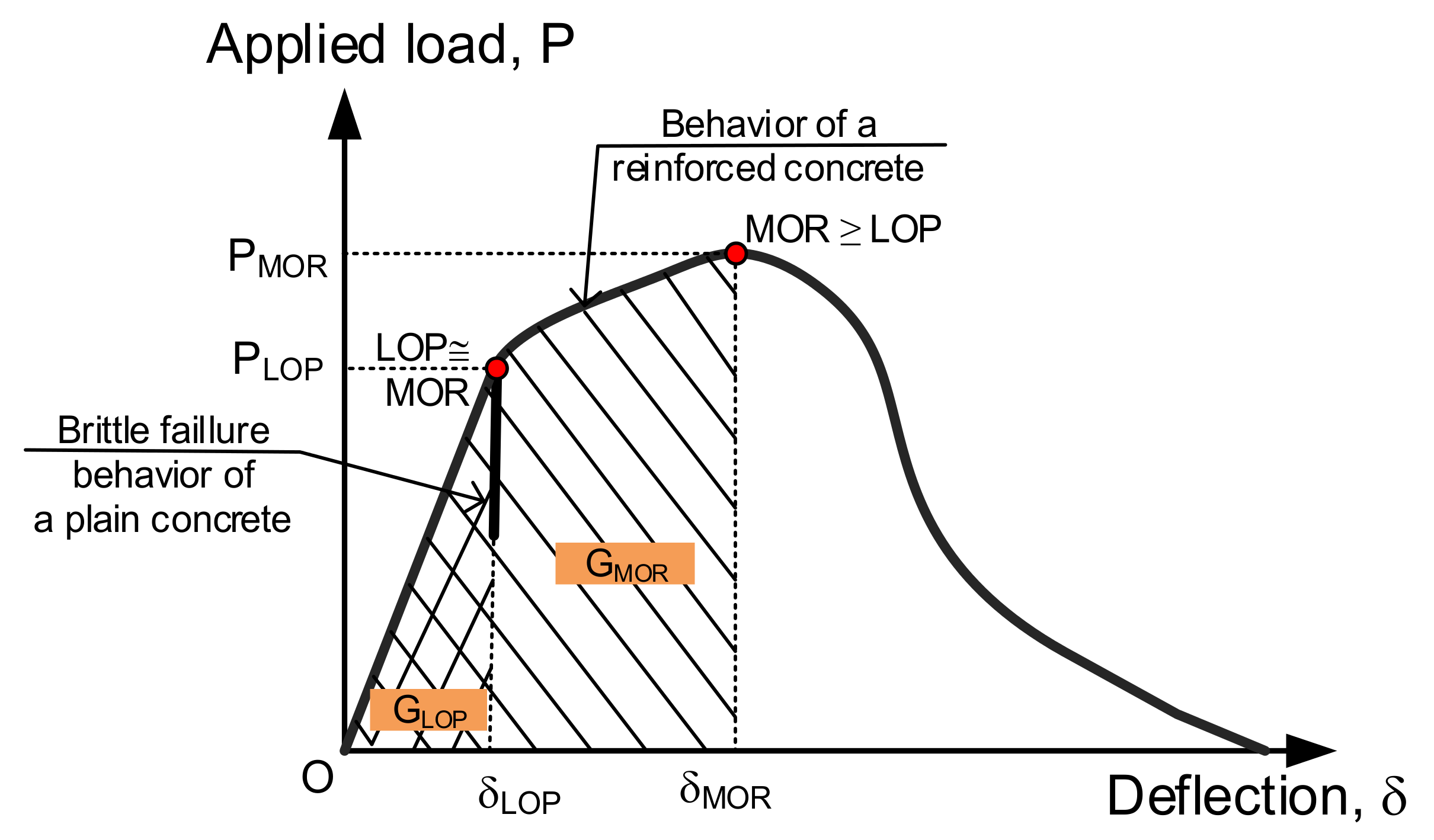
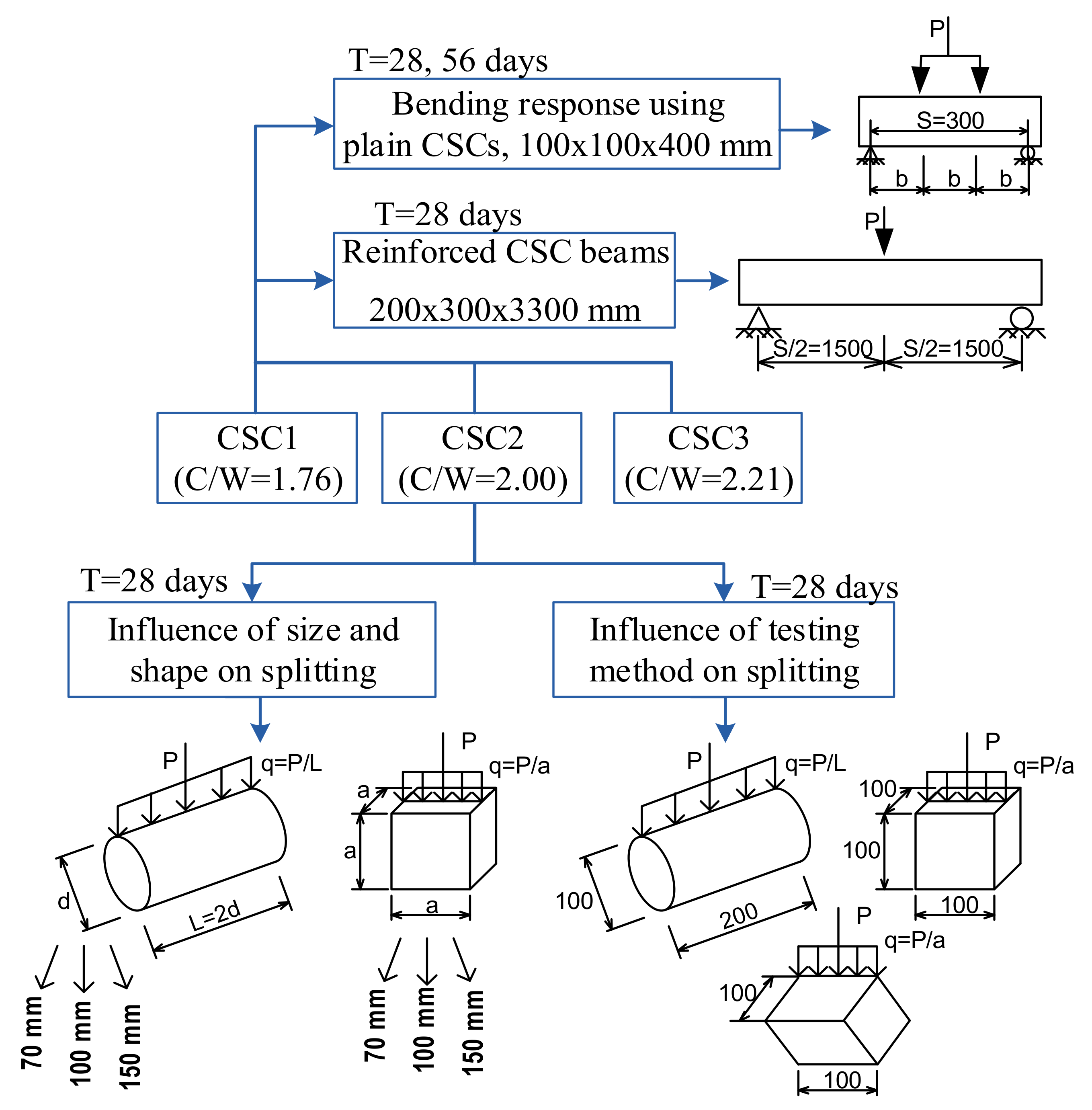


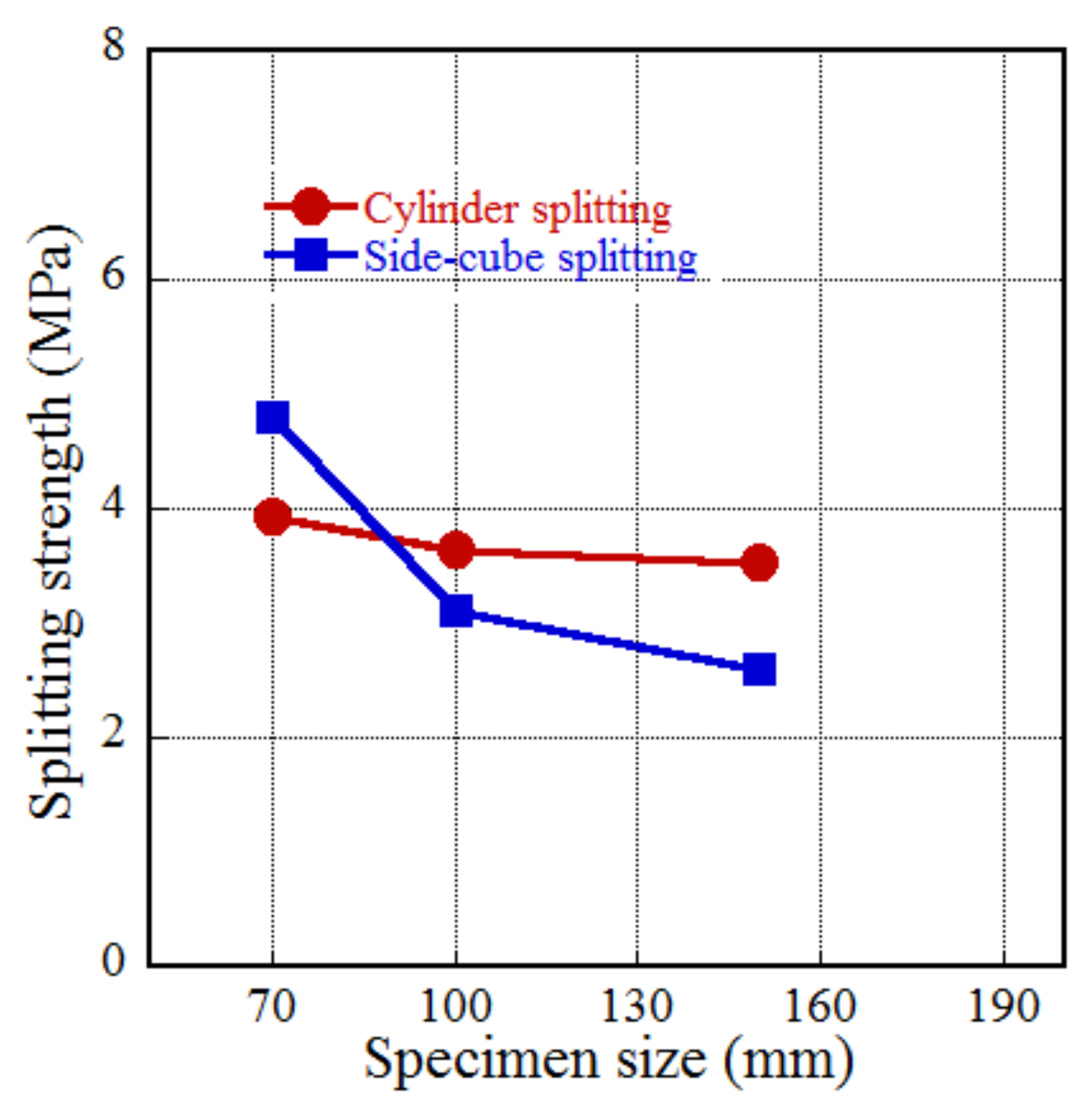
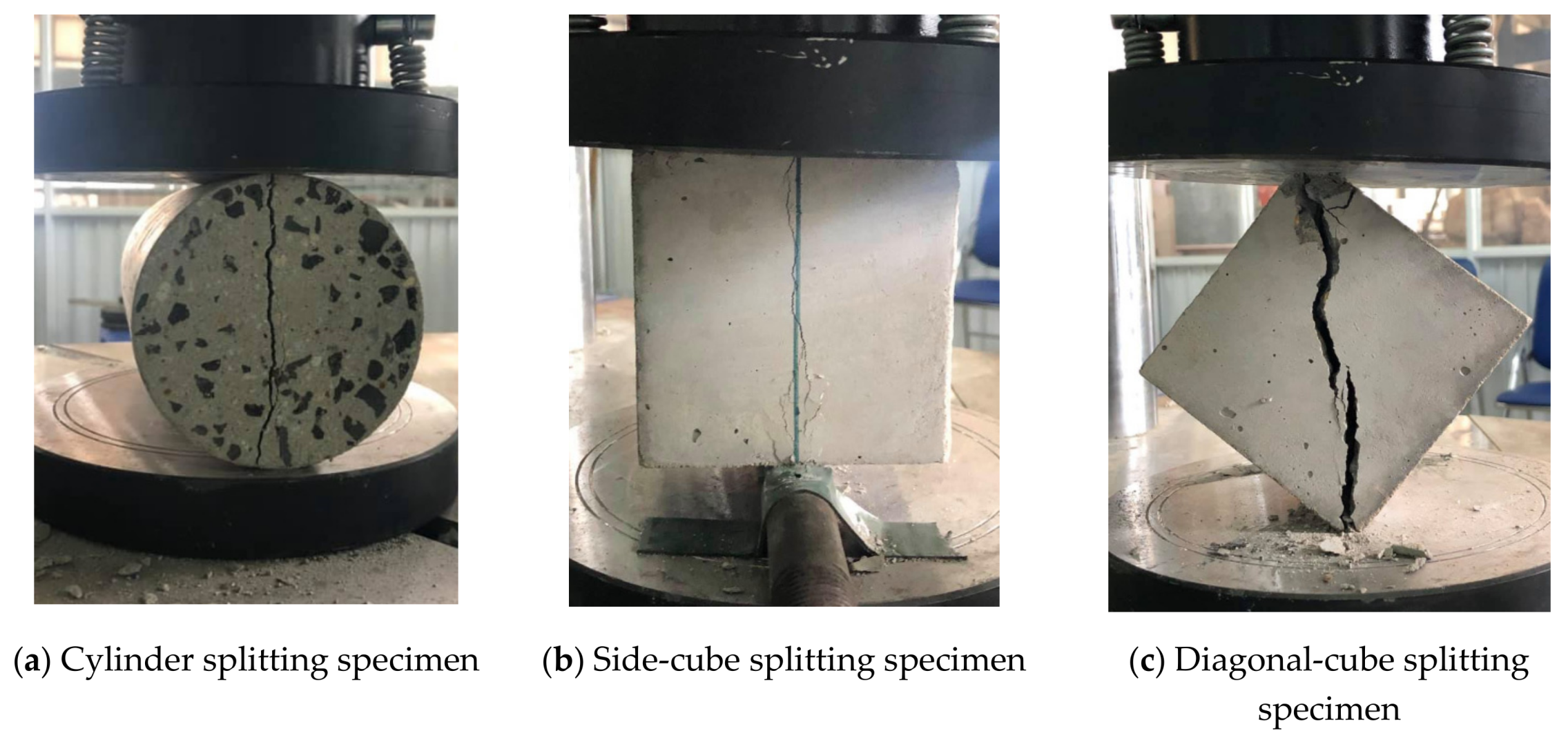
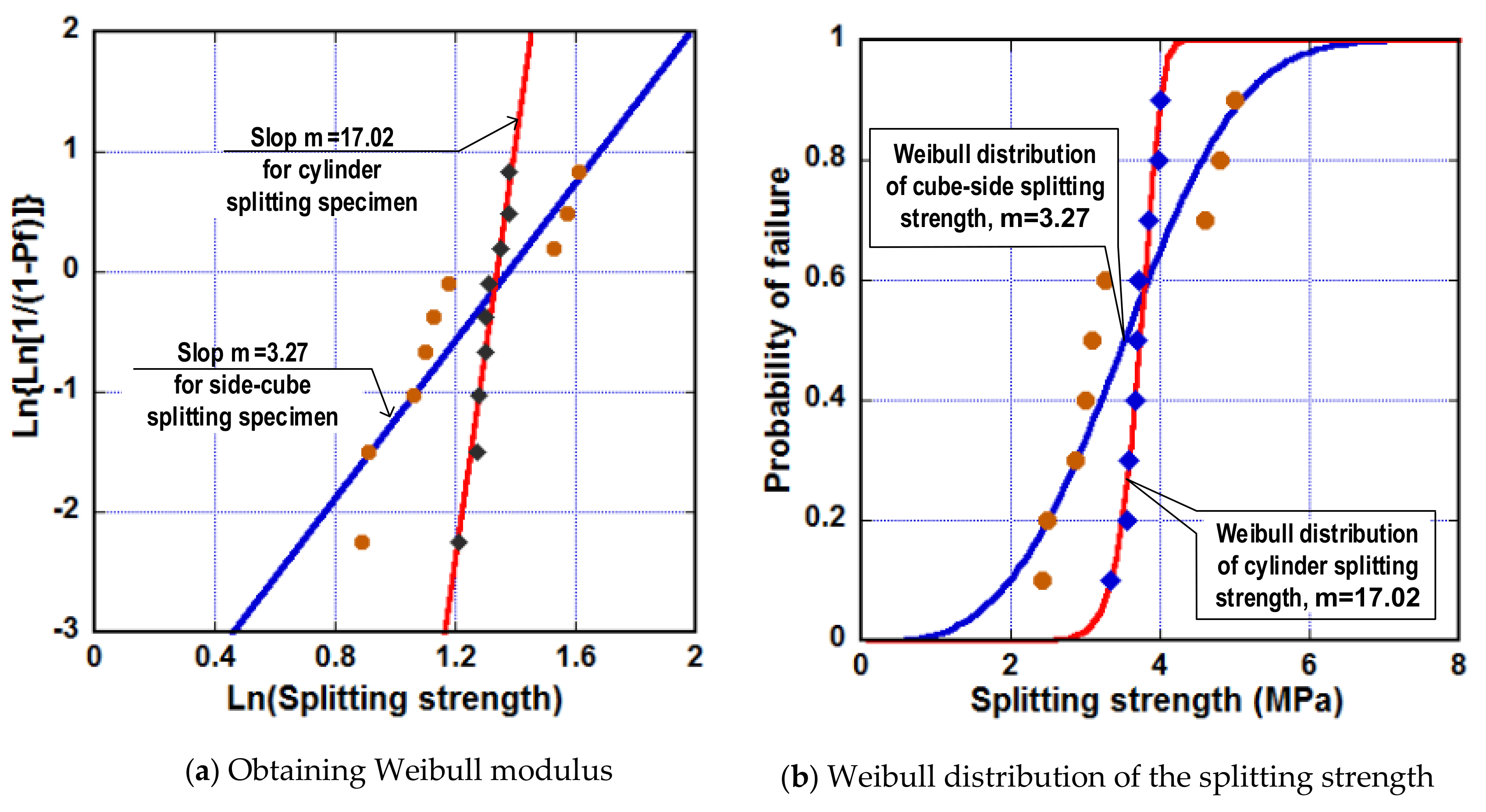
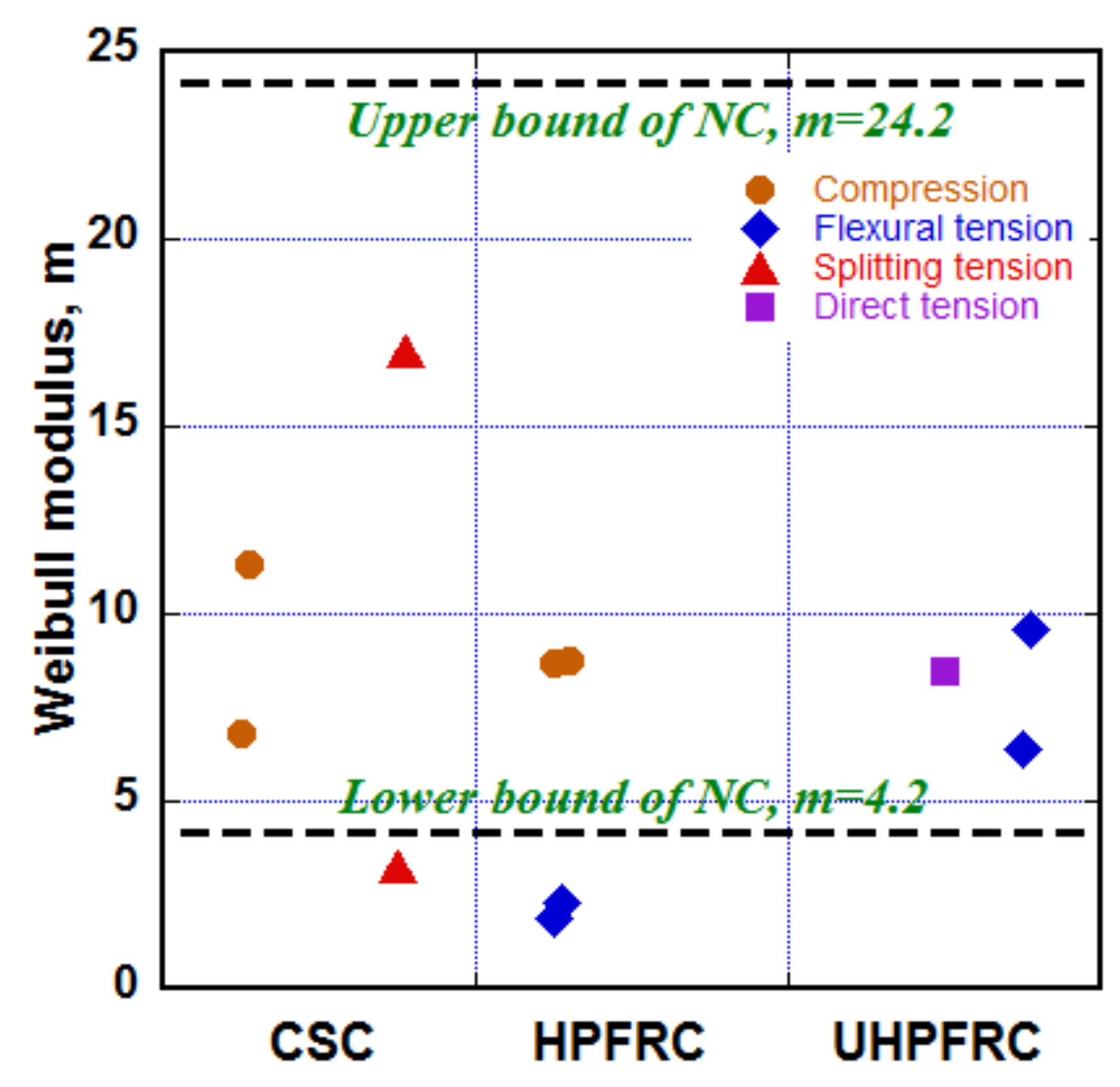
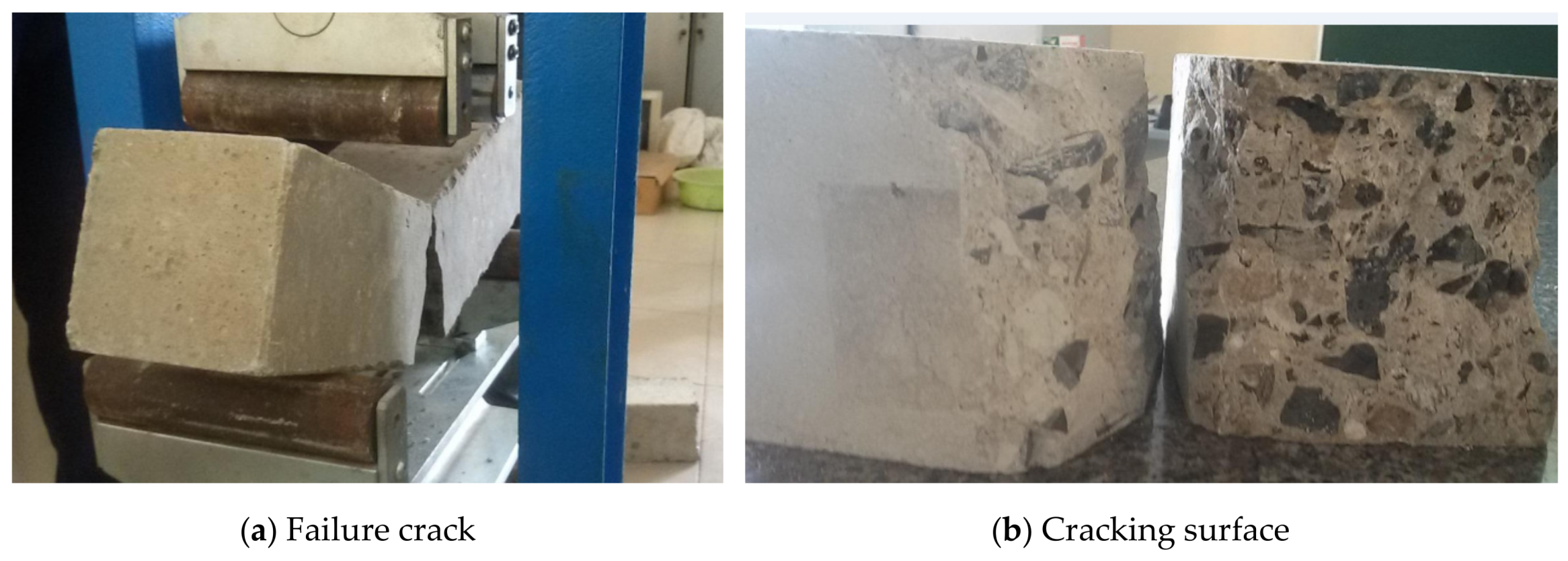
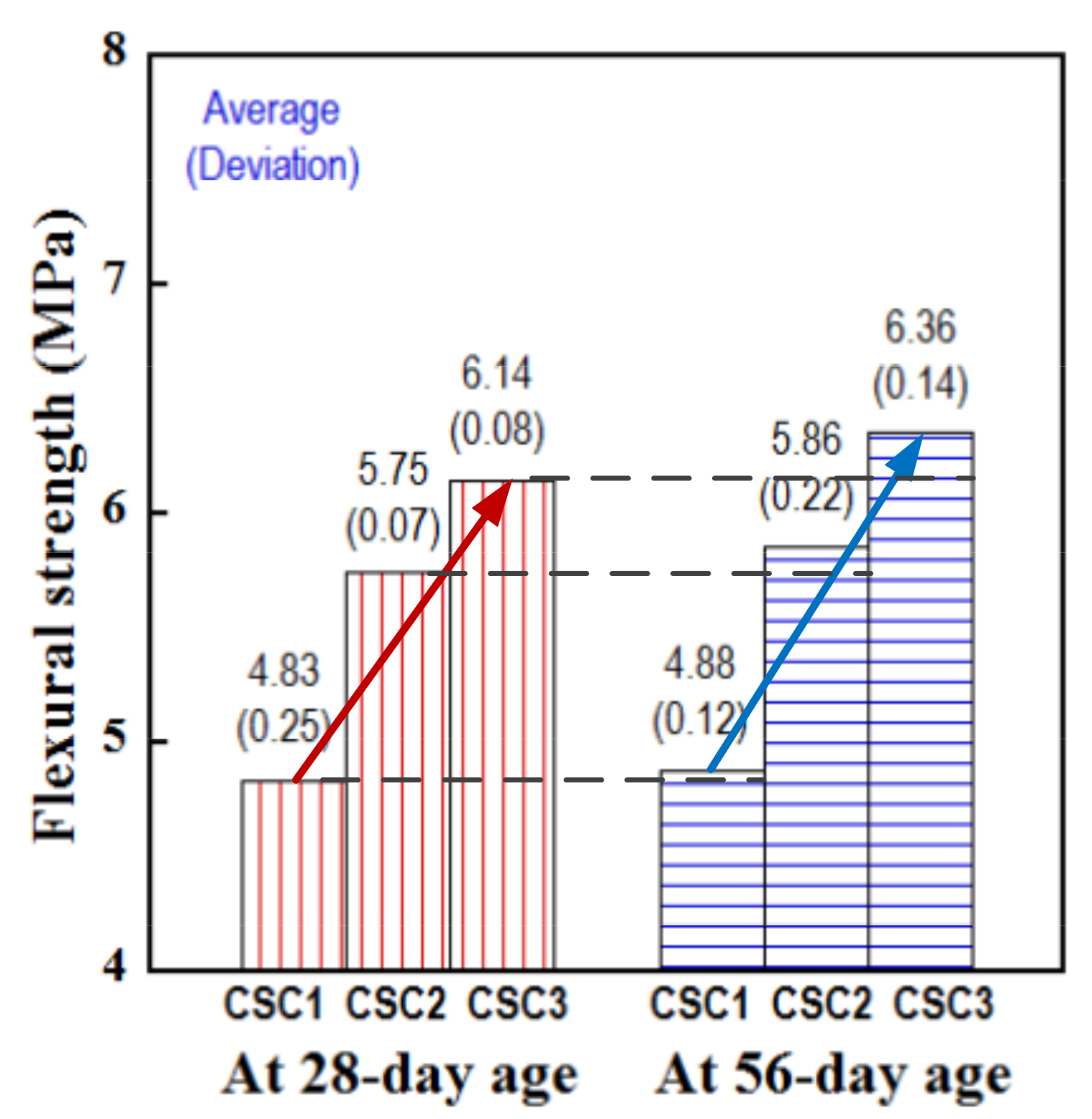
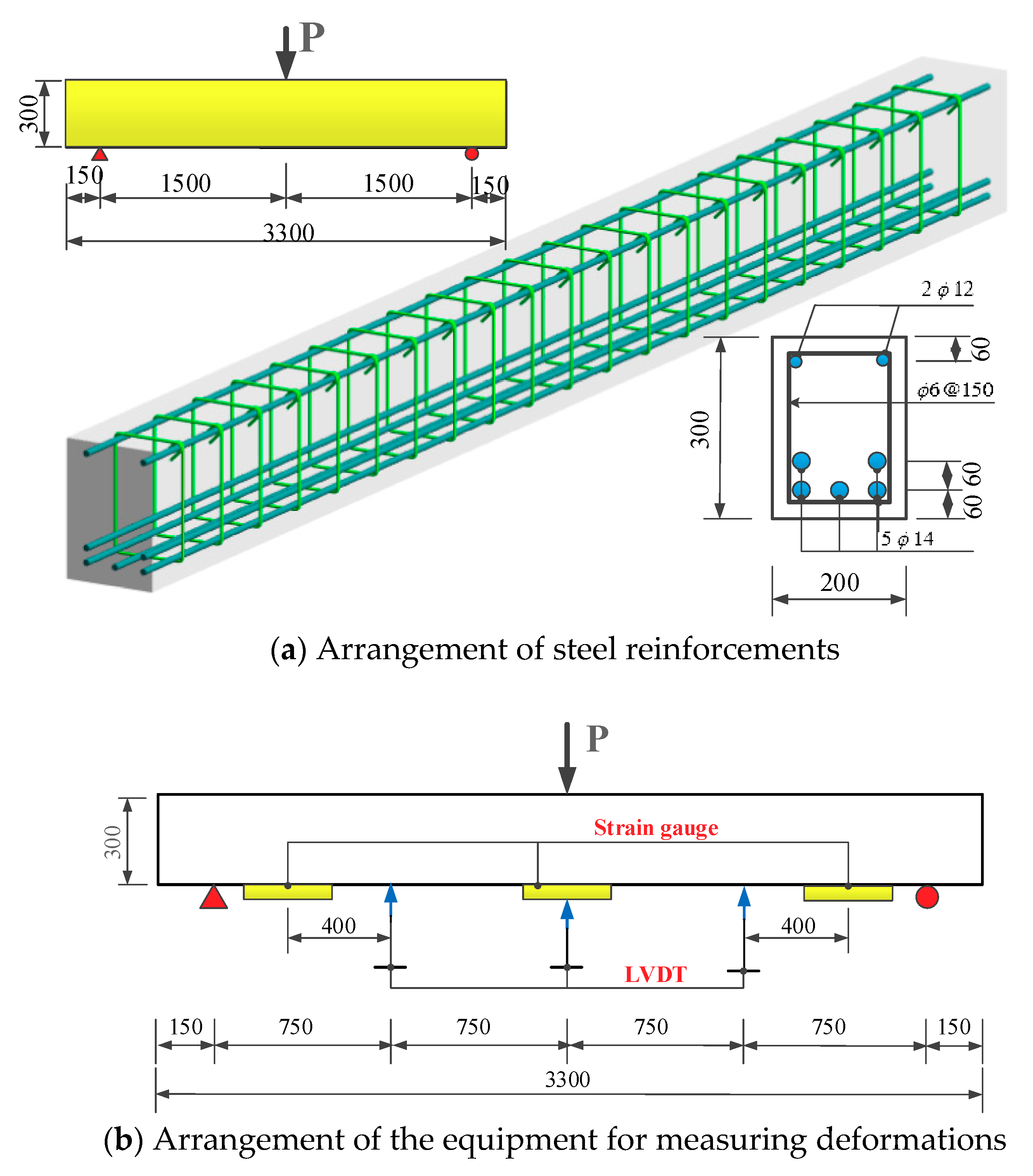

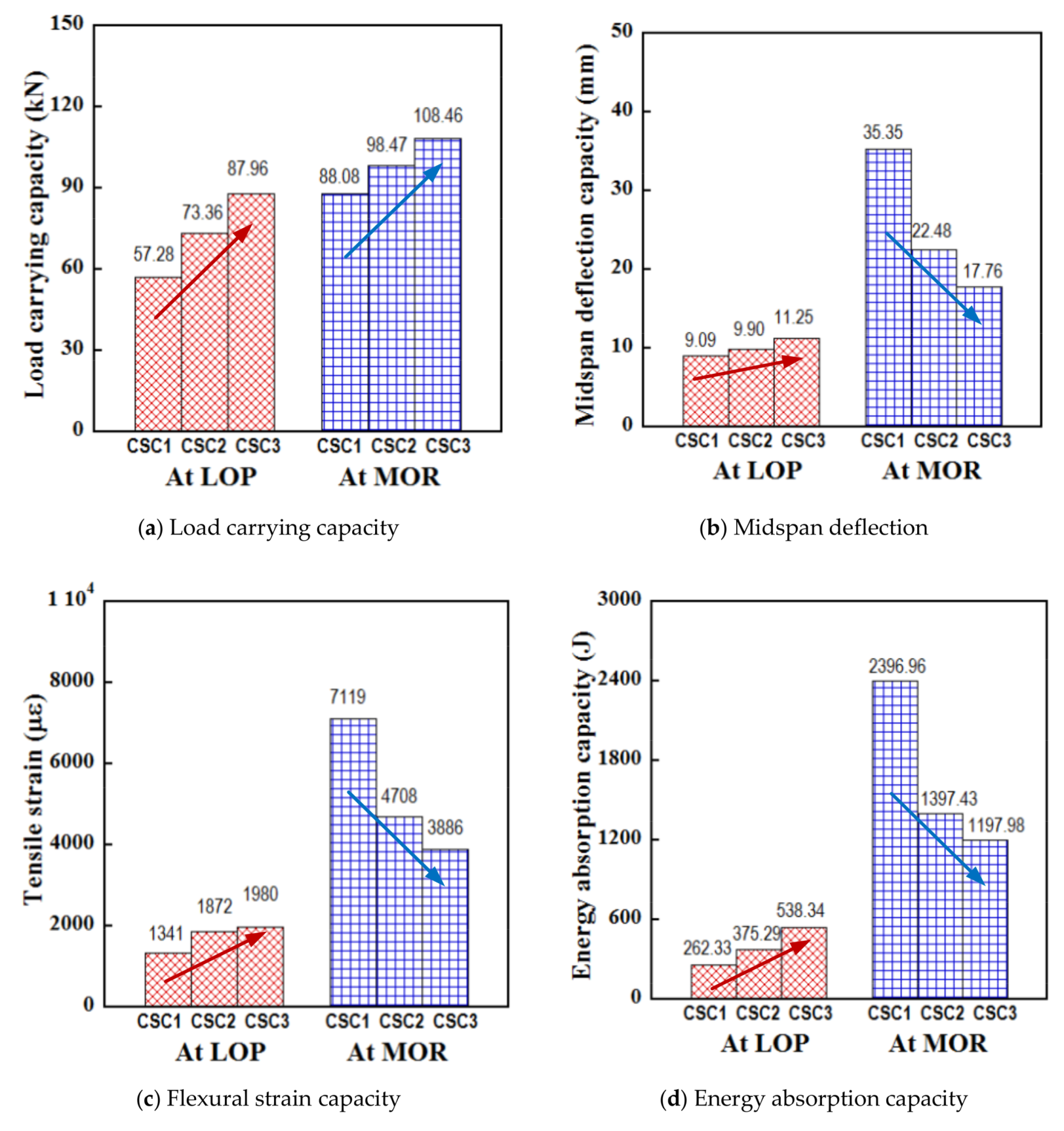
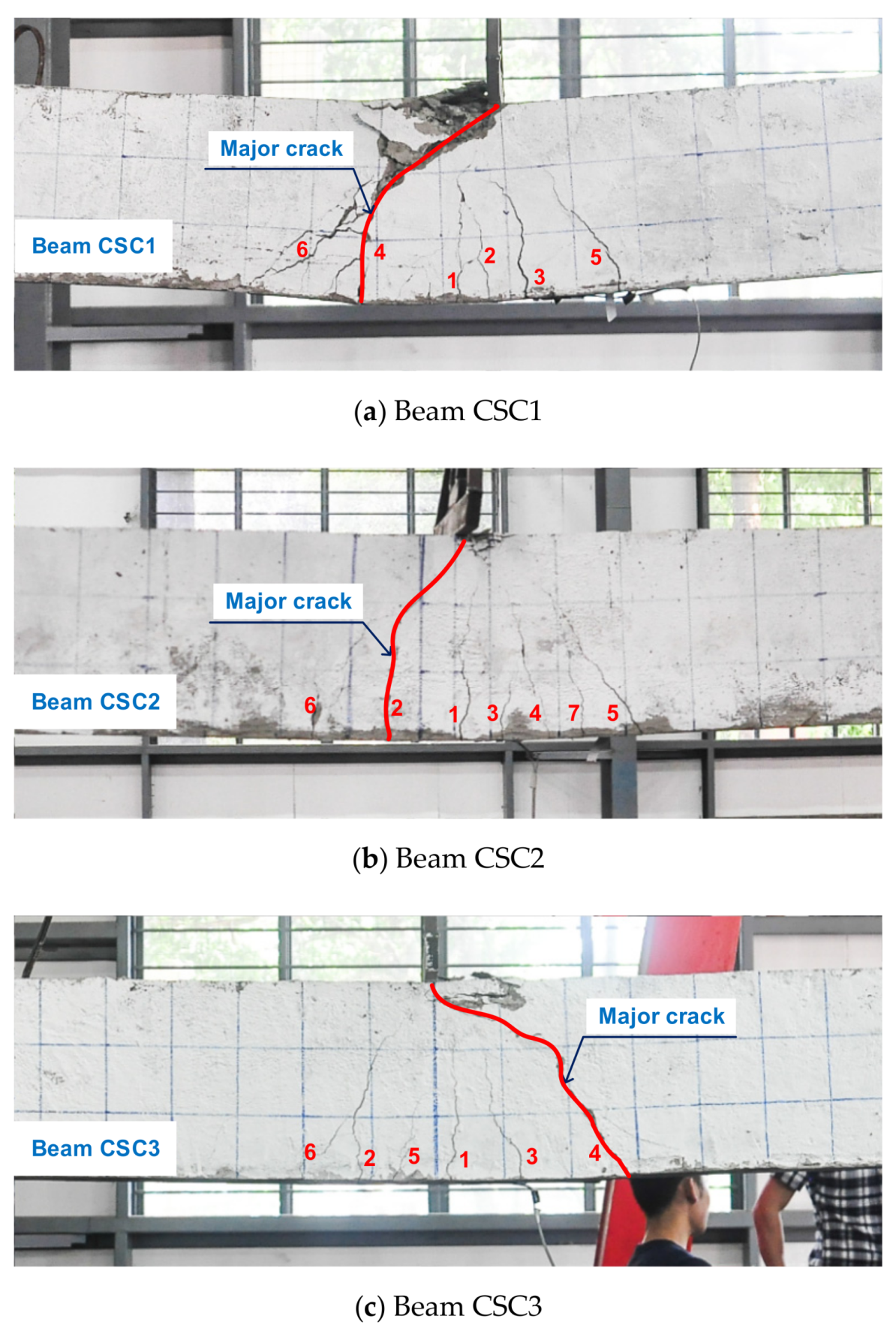
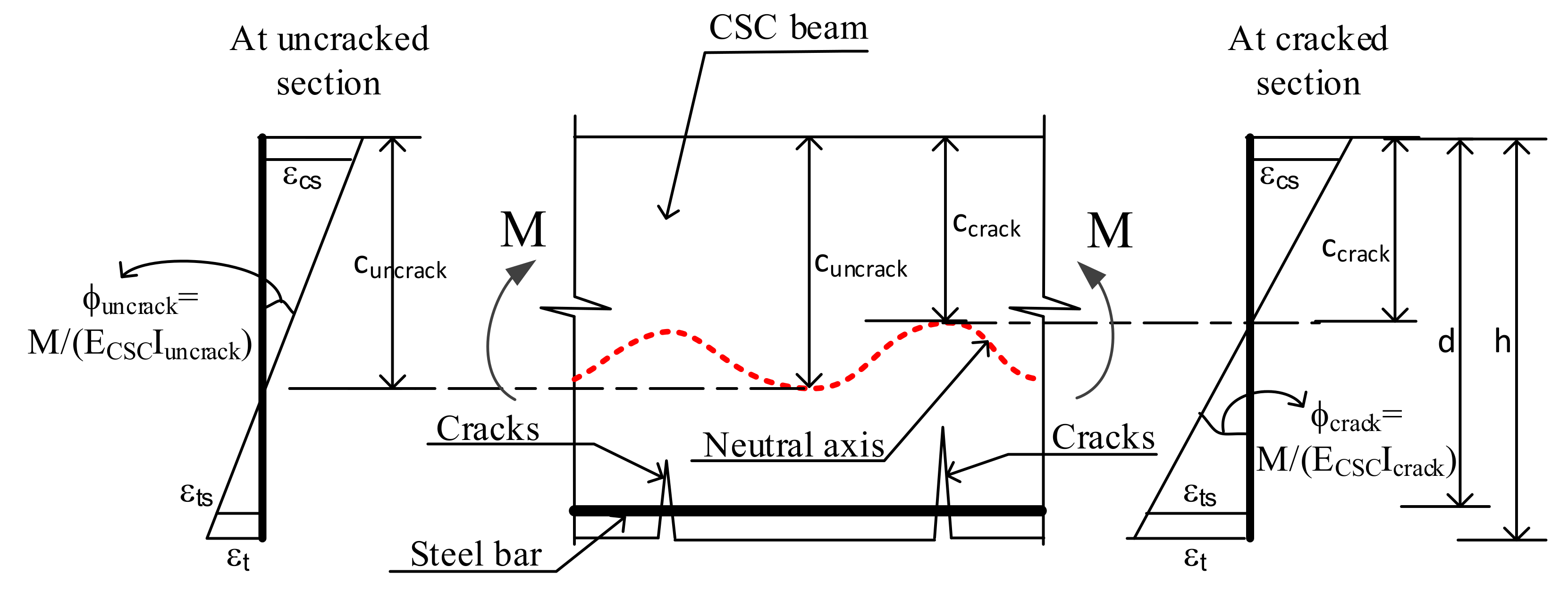
| Mixture | Cement (Kg/m3) | Fine River Sand (Kg/m3) | Coarse Steel Slag (Kg/m3) | Water (Kg/m3) | (MPa) | (GPa) |
|---|---|---|---|---|---|---|
| CSC1 | 385 | 740 | 1466 | 219 | 22.91 | 31.12 |
| CSC2 (control) | 437 | 722 | 1432 | 219 | 32.26 | 36.68 |
| CSC3 | 485 | 706 | 1400 | 219 | 35.68 | 39.21 |
| River Sand | Coarse Steel Slag | ||
|---|---|---|---|
| Size of Sieve (mm) | Pass (%) | Size of Sieve (mm) | Pass (%) |
| 4.75 | 100 | - | - |
| 2.36 | 91.5 | - | - |
| 1.18 | 73.4 | 37.5 | 100 |
| 0.6 | 54 | 19 | 91 |
| 0.3 | 24.5 | 9.5 | 44 |
| 0.15 | 7 | 4.75 | 5.1 |
| <0.14 | 0.0 | <4.75 | 0 |
| SiO2 | Al2O3 | FeO | Fe2O3 | CaO | MgO | Na2O | K2O | TiO2 | P2O5 | SO3 | Loss on Ignition |
|---|---|---|---|---|---|---|---|---|---|---|---|
| 55.27 | 18.56 | 0.20 | 11.66 | 5.77 | 1.85 | 1.34 | 1.72 | 1.02 | 1.48 | 0.39 | 0.21 |
| Physical Properties | Coarse Steel Slag | |
|---|---|---|
| Dmin–Dmax | 5–20 | mm |
| Specific gravity | 3.56 | g/cm3 |
| Bulk dry specific gravity | 3.32 | g/cm3 |
| Bulk saturated surface dry specific gravity | 3.39 | g/cm3 |
| Water absorption | 2.1 | % |
| Bulk density | 1720 | kg/m3 |
| Voids | 48.2 | % |
| Specimen Type (Specimen Name) Formula | Parameter | Maximum Force, | Splitting Strength |
|---|---|---|---|
| 70.7 × 70.7 × 70.7 (S-CU070) | Specimen1 | 53.80 | 5.00 |
| Specimen2 | 49.48 | 4.60 | |
| Specimen3 | 51.66 | 4.80 | |
| Average value | 51.64 | 4.80 | |
| Standard deviation | 2.16 | 0.20 | |
| 100 × 100 × 100 (S-CU100) | Specimen1 | 70.07 | 3.26 |
| Specimen2 | 64.43 | 2.99 | |
| Specimen3 | 66.57 | 3.09 | |
| Average value | 67.03 | 3.11 | |
| Standard deviation | 2.85 | 0.13 | |
| 150 × 150 × 150 (S-CU150) | Specimen1 | 120.64 | 2.49 |
| Specimen2 | 139.16 | 2.87 | |
| Specimen3 | 117.88 | 2.43 | |
| Average value | 125.89 | 2.60 | |
| Standard deviation | 11.57 | 0.24 | |
| Ø70 × 140 (CY070) | Specimen1 | 59.28 | 3.85 |
| Specimen2 | 61.46 | 3.99 | |
| Specimen3 | 61.10 | 3.97 | |
| Average value | 60.61 | 3.94 | |
| Standard deviation | 1.17 | 0.08 | |
| Ø100 × 200 (CY100) | Specimen1 | 116.40 | 3.71 |
| Specimen2 | 111.40 | 3.55 | |
| Specimen3 | 115.59 | 3.68 | |
| Average value | 114.46 | 3.64 | |
| Standard deviation | 2.68 | 0.09 | |
| Ø150 × 300 (CY150) | Specimen1 | 259.03 | 3.66 |
| Specimen2 | 253.47 | 3.59 | |
| Specimen3 | 236.11 | 3.34 | |
| Average value | 249.54 | 3.53 | |
| Standard deviation | 11.96 | 0.17 | |
| 100 × 100 × 100 (D-CU100) | Specimen1 | 56.40 | 2.93 |
| Specimen2 | 59.98 | 3.82 | |
| Specimen3 | 61.67 | 3.93 | |
| Average value | 59.35 | 3.56 | |
| Standard deviation | 2.69 | 0.55 |
| Testing Type of Splitting | Basic Specimen | |||||||
|---|---|---|---|---|---|---|---|---|
| S-CU070 | S-CU100 | S-CU150 | CY070 | CY100 | CY150 | D-CU100 | ||
| CSC | CY150 | 0.74 | 1.13 | 1.36 | 0.90 | 0.97 | 1.00 | 0.99 |
| NC, dmax 5 mm [39] | CY150 | - | - | - | 090 | 0.95 | 1.00 | - |
| NC, dmax 15 mm [39] | CY150 | - | - | - | 0.76 | 0.73 | 1.00 | - |
| Concrete Kind | Testing Type | |||
|---|---|---|---|---|
| Compression | Direct Tension | Flexural Tension | Splitting Tension | |
| CSC | 6.80; 11.32 [21] | - | - | 3.27; 17.02 [this study] |
| HPFRC | 8.69; 8.74 [39] | - | 1.90; 2.31 [39] | - |
| UHPFRC | - | 8.50 [40] | 6.40; 9.60 [41] | - |
| NC deviation | 4.20 ÷ 24.2 [42] | |||
| Matrix Type | Specimen | Testing at 28 days | Testing at 56 days | ||
|---|---|---|---|---|---|
| Specimen1 | 16.54 | 4.96 | 15.96 | 4.79 | |
| Specimen2 | 16.62 | 4.99 | 16.10 | 4.83 | |
| CSC1 | Specimen3 | 15.13 | 4.54 | 16.71 | 5.01 |
| Average value | 16.10 | 4.83 | 16.26 | 4.88 | |
| Standard deviation | 0.84 | 0.25 | 0.40 | 0.12 | |
| Specimen1 | 19.19 | 5.76 | 20.39 | 6.12 | |
| Specimen2 | 18.93 | 5.68 | 19.27 | 5.78 | |
| CSC2 | Specimen3 | 19.40 | 5.82 | 18.98 | 5.69 |
| Average value | 19.17 | 5.75 | 19.55 | 5.86 | |
| Standard deviation | 0.23 | 0.07 | 0.74 | 0.22 | |
| Specimen1 | 20.33 | 6.10 | 21.39 | 6.42 | |
| Specimen2 | 20.29 | 6.09 | 20.67 | 6.20 | |
| CSC3 | Specimen3 | 20.79 | 6.24 | 21.56 | 6.47 |
| Average value | 20.47 | 6.14 | 21.21 | 6.36 | |
| Standard deviation | 0.28 | 0.08 | 0.47 | 0.14 | |
| Type of Steel Bar | Yield Strength (MPa) | Ultimate Tensile Strength (MPa) | Modulus of Elasticity (GPa) | Shape Surface |
|---|---|---|---|---|
| Ø6 | 240 | 380 | 200 | plain |
| Ø12, Ø14 | 400 | 570 | 200 | deformed |
| Beam Name | Load at LOP, (kN) | Midspan Deflection at LOP | Flexural Strain at LOP | Energy at LOP, (J) | Load at MOR, (kN) | MidSpan Deflection at MOR | Flexural Strain at MOR | Energy at MOR, (J) |
|---|---|---|---|---|---|---|---|---|
| Beam CSC1 | 57.28 | 9.08 | 1341 | 262.33 | 88.08 | 35.35 | 7119 | 2396.96 |
| Beam CSC2 | 73.36 | 9.90 | 1872 | 375.29 | 98.47 | 22.48 | 4708 | 1397.43 |
| Beam CSC3 | 87.96 | 11.25 | 1980 | 538.34 | 108.46 | 17.76 | 3886 | 1197.98 |
| Beam Name | Load at LOP, (kN) | Elastic Modulus of CSC | Location of Neutral Axis at LOP | Equivalent Moment of Inertia | Flexural Strength at LOP |
|---|---|---|---|---|---|
| Beam CSC1 | 57.28 | 31.12 | 153 | 481,328,912 | 13.16 |
| Beam CSC2 | 73.36 | 36.68 | 152 | 475,762,177 | 17.10 |
| Beam CSC3 | 87.96 | 39.21 | 152 | 473,745,984 | 20.62 |
| Beam Name | Midspan Deflection at LOP/MOR (mm) | Curvature at LOP/MOR (1/m) | Location of Neutral Axis at LOP/MOR (mm) | Derived Flexural Strain at LOP/MOR | Measured Flexural Strain at LOP/MOR | Difference (%) |
|---|---|---|---|---|---|---|
| Beam CSC1 | 9.08/35.35 | 0.0101/0.0393 | 153/82 | 1488/8563 | 1341/7119 | 10/17 |
| Beam CSC2 | 9.90/22.48 | 0.0110/0.0250 | 152/64 | 1627/5895 | 1872/4690 | 15/20 |
| Beam CSC3 | 11.25/17.76 | 0.0125/0.0197 | 152/76 | 1851/4736 | 1980/3886 | 7/18 |
| Beam Name | Compressive Strength | Location of Neutral Axis at MOR | Estimated Moment Resistance, | Experimental Moment | Difference (%) |
|---|---|---|---|---|---|
| Beam CSC1 | 22.91 | 93 | 61.72 | 67.75 | 9 |
| Beam CSC2 | 32.26 | 68 | 65.25 | 75.54 | 14 |
| Beam CSC3 | 35.68 | 64 | 66.08 | 83.03 | 20 |
© 2020 by the authors. Licensee MDPI, Basel, Switzerland. This article is an open access article distributed under the terms and conditions of the Creative Commons Attribution (CC BY) license (http://creativecommons.org/licenses/by/4.0/).
Share and Cite
Nguyen, T.-T.-H.; Mai, H.-H.; Phan, D.-H.; Nguyen, D.-L. Responses of Concrete Using Steel Slag as Coarse Aggregate Replacement under Splitting and Flexure. Sustainability 2020, 12, 4913. https://doi.org/10.3390/su12124913
Nguyen T-T-H, Mai H-H, Phan D-H, Nguyen D-L. Responses of Concrete Using Steel Slag as Coarse Aggregate Replacement under Splitting and Flexure. Sustainability. 2020; 12(12):4913. https://doi.org/10.3390/su12124913
Chicago/Turabian StyleNguyen, Thi-Thuy-Hang, Hong-Ha Mai, Duc-Hung Phan, and Duy-Liem Nguyen. 2020. "Responses of Concrete Using Steel Slag as Coarse Aggregate Replacement under Splitting and Flexure" Sustainability 12, no. 12: 4913. https://doi.org/10.3390/su12124913





